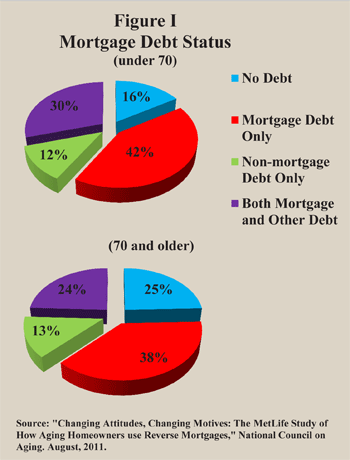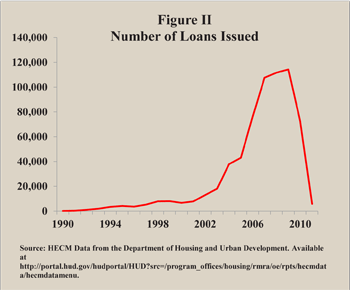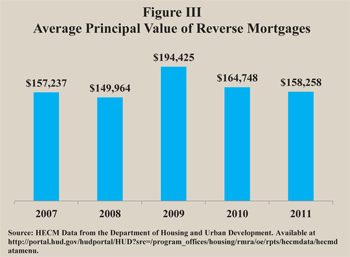Television advertisements make reverse mortgages sound appealing. Some ads make misleading statements such as a borrower “will never lose your home,” or that a reverse mortgage is a “government benefit,” but there are several untoward things that can happen if borrowers do not fully understand the terms.
Furthermore, because the Federal Housing Administration (FHA) insures reverse mortgages, future taxpayers could be on the hook for billions of dollars.
How A Reverse Mortgage Works. Reverse mortgages allow homeowners age 62 or older to borrow against their home equity and receive the money in the form of a steady stream of income (annuity), a lump sum payment or a line of credit they can draw on. Reverse mortgages differ from home equity loans in that repayment of the loan is not due until the loan recipients die or move out of the home. As long as the borrowers continue to live in the home, they can receive payments until death. Once the borrowers die, however, the loan must be paid back either through the sale of the home or with other funds from the borrower’s estate. If the loan amount exceeds the value of the home when the loan comes due, the house becomes the property of the lender. If proceeds from the sale of the home are insufficient to pay the outstanding loan balance, lenders can file an insurance claim with the FHA.
How Much Money Can a Reverse Mortgage Provide? The amount that a borrower can obtain through a reverse mortgage is based on two main criteria: the amount of equity in the borrower’s home and the borrowers’ age. Thus:
- A single individual must be at least 62 years old in order to apply for a reverse mortgage; for a married couple, both spouses must be 62 years of age.
- The older the borrower, the more home equity he can access. For instance, a 62-year old borrower may only receive about 40 percent of his home’s equity, whereas a 72-year old borrower could access about 60 percent of home equity.
The loan is not without cost. Like a conventional mortgage, reverse mortgages accrue interest, but the interest is not due until an event occurs that triggers repayment. Lenders also charge up-front fees, which include:
- Mortgage insurance, which is charged as both an up-front fee ranging from 0.02 percent to 2 percent (depending on the specific loan terms) and an annual charge equal to 1.25 percent of the loan balance.
- An origination fee based on the loan amount, but not more than $6,000.
- Miscellaneous service fees.
Lenders subtract these fees from the lump-sum or monthly payments the borrower receives.

Types of Loans Available. Mortgage companies have offered different types of loans, similar to conventional mortgages, including a fixed-rate (known as the Standard Fixed Rate HECM), a lower-cost, fixed-rate mortgage (the “Saver” plan) and a variable-rate mortgage. However, this year the FHA eliminated Standard Fixed Rate HECMs, which have higher upfront fees and more generous loan amounts.1 Instead, the FHA now only allows “Saver” plans for fixed-rate mortgages, which charge lower fees but offer 10 percent to 20 percent less payout than standard mortgages.
Reverse mortgages can generally be used to pay off an existing conventional mortgage if the balance owed does not exceed the amount of the reverse mortgage.
Demographics of Reverse Mortgagees. Although reverse mortgages are limited to seniors, borrowers are applying at earlier ages. According to a Met Life survey, the average borrower is 71.5 years old, but one in five borrowers are ages 62 to 64.2 Moreover, two-thirds of borrowers are using reverse mortgages to pay down debt (including conventional mortgage debt), while only 27 percent use the mortgages to enhance their lifestyle.
Younger borrowers are far more likely to have mortgage debt than older borrowers, with or without other types of debt. [See Figure I.]
- Some 70 percent of borrowers under age 70 had mortgage debt, with or without other debts.
- Only 16 percent of borrowers under age 70 had no debt at all.
- About 62 percent of borrowers age 70 and over had mortgage debt, and only 25 percent had no debt at all.
The survey also found that about one-third of homeowners using reverse mortgages have a mortgage balance that is at least half of their home value. This troubling trend will increase as more baby boomers enter retirement with mortgage debt than previous generations.

The Downside to Reverse Mortgages. Reverse mortgages can be considered in default if the homeowner fails to pay annual property taxes and homeowner’s insurance or maintain the property. In the event of default, the lender ceases monthly payments to the borrower and may foreclose on the property.
Other circumstances might take borrowers completely by surprise if they do not understand the terms of their agreement, potentially losing their home. For instance:
- If only one spouse’s name is on the house deed, the reverse mortgage could become due and payable upon the death of that spouse. If the surviving spouse cannot pay the loan debt, the lender can foreclose on the property.
- If the total payments from the reverse mortgage loan exceed the home’s current value, — for example, if the home’s value falls over time — the borrower is not liable for the difference; however, this may not always be the case with non-FHA guaranteed loans..
Lenders who help borrowers obtain reverse mortgages are required to inform them orally of their rights and responsibilities. However, a Government Accountability Office audit of 15 lenders found that none of them covered all of the required topics:3
- Seven of the 15 lenders did not provide information about less-complicated financial options than a reverse mortgage.
- Fourteen of the 15 lenders only partially met the disclosure requirements — principally, disclosing information about the financial implications of a reverse mortgage — and the same lenders did not tell borrowers the borrowers could opt to have the lender withhold funds in an escrow account to pay insurance and property taxes.
- Fourteen of the 15 lenders failed to ask the homeowners if they had signed a contract or agreement with an estate planning service, a question that is required by the FHA.

The Risk to Taxpayers. The FHA regulates reverse mortgages, and the rules have changed over time. In particular, the Housing and Economic Recovery Act of 2008 (HERA) capped the origination fee lenders could charge borrowers, which led to fewer lenders offering reverse mortgages. On the other hand, HERA also increased the maximum loan amount to $417,000, surpassing the previous limits based on home values in the county where the house is located, which were often much lower. The American Recovery and Reinvestment Act again increased the limit in 2009 to $625,000 thus giving more lenders an incentive to offer reverse mortgages. These changes appeared to reinvigorate the reverse mortgage market [see Figures II and III]:
- The largest number of reverse mortgages were issued in 2007 to 2009, with an average loan amount of $157,000 in 2007 and $150,000 in 2008.
- The issuance of new reverse mortgages rose to more than 114,000 in 2009, and the average loan amount peaked at $194,425.
- By 2011, the number of new reverse mortgages issued fell to 57,774 — the lowest level since 2005 — likely due to declining home values after the housing bubble burst.
The FHA insures reverse mortgages, which provides lenders with a strong incentive to issue them, because they can claim compensation in the event of a default. But this government support means that taxpayers could foot the bill for any number of defaulted mortgages:
- The FHA’s 2012 financial statement reveals about $140 billion in outstanding FHA-insured reverse mortgage loans.
- The federal Consumer Financial Protection Bureau reported in 2012 that, about 9.4 percent of reverse mortgages were at risk of default — nearly double the default risk for ordinary home mortgages (about 5 percent).
- The Government Accountability Office reported that projected defaults in 2010 would alone require a taxpayer subsidy of $789 million.4
Conclusion. With a much higher default rate than traditional mortgages, reverse mortgages and their inherent risks should be left up to the market, not the Federal Housing Administration. If lenders cannot and will not bear the risk, the reverse mortgage market should not exist in the first place.
Pamela Villarreal is a senior fellow with the National Center for Policy Analysis.
Endnotes
1. “FHA to Halt Fixed Rate Standard Reverse Mortgage Starting April 1,” Reverse Mortgage Daily, January 30, 2013.
2. “Changing Attitudes, Changing Motives: The MetLife Study on How Aging Homeowners Use Reverse Mortgages,” MetLife Mature Market Institute and National Council on Aging, August 2011.
3. “Reverse Mortgages: Product Complexity and Consumer Protection Issues Underscore Need for Improved Controls over Counseling for Borrowers,” Government Accountability Office, GAO-09-812T, June 29, 2009.
4. Ibid. A credit subsidy is the net present value of estimated payments by the government to cover defaults and delinquencies, interest subsidies, or other payments, offset by any payments to the government, including origination and other fees, penalties and recoveries.